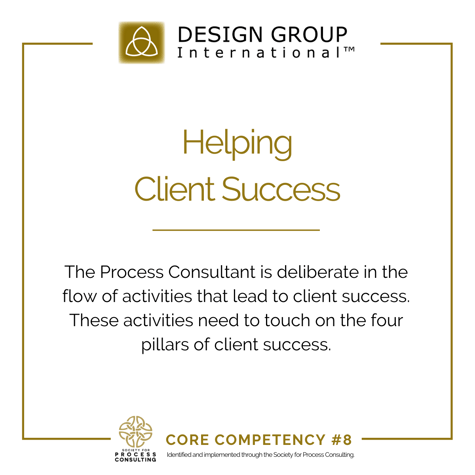
How does client success differ from client satisfaction? The most basic distinction is that client satisfaction prioritizes the work of the consultant, keeping the focus on completing tasks, while client success understands that the client must remain at the center of any engagement. Helping clients by focusing on their success requires a consultant willing to learn and grow with the client, not one who arrives with ready-made answers.
When I think of client success, and attempt to differentiate between client satisfaction and client success, I reflect on one of my earliest consulting engagements. I was working in a different field and did not consider myself a process consultant, though I called on many of the same concepts and thinkers who have shaped process consulting.
I received a referral from an existing client to chat with an aspiring author. She provided a laundry list of items that needed to be checked off, everything from design to marketing to public relations, and even editing. I realized quickly that she created this list based on what someone told her an author needed, not on her own desires and situation. I replied that I would not be able to help her with her to-do list, but if she wanted to work together on a plan to write, edit, promote, and market her book, I was happy to work beside her. We worked together for a year and a half, she finished the book on time, and had an engaged audience waiting for it’s release.
If my focus was client satisfaction, I would have reviewed her to-do list, made a plan to accomplish the tasks she created, and got to work on the project. The tasks would have been completed without regard to their importance or their connection to the successful launch of her book and website. Client satisfaction centers the work of the consultant and the completion of tasks. Consultants who chase client satisfaction, by itself, are more focused on their accomplishments than the success of their clients.
Client success focuses on the client and their goals, not tasks. The process consultant guides the client through a journey that produces success, even if that success is difficult, frustrating to accomplish, or requires different work than expected. The satisfaction of the client comes not from the work of the consultant, but from the realization of their dreams and goals.

Of course, client success is only one component of Design Group International’s process consulting core competencies. If you’re visiting for the first time, I encourage you to read my colleagues’ previous posts explaining how process consulting is a departure from traditional consulting. Process consulting starts with listening to fully understand what is being said, what is behind those words, how to design a process that works for each client, and how to adapt and learn. Once you understand more about how we start by listening, you can learn how we move into helping our clients, by creating processes that center the client, and ensuring the client is comfortable owning the work we co-create.
I would love to chat more about process consulting and how our work helps you find success, not just satisfaction. Please reach out and we’ll find time to discuss your unique situation and my work might help you find the clarity, capacity, and success that you and your organization deserve. You can reach me at ericd@designgroupintl.com, by phone at 410-300-1170, or you can book a call directly using this link.
Walking Alongside,

 Eric Doss
Eric Doss
Design Group International
Senior Consultant
Dig Deeper:
Want to explore more on this topic? Take a look at these resources:
- Nick Mehta on Customer Success
- Philipp Wolf on the Difference between Customer Success and Customer Support.
Process Consulting competencies identified and implemented through
the Society for Process Consulting.
Tags:
process design, process consulting, kim stezala, Design Group International, listening, helping, learning, Ed Schein, organizational consulting, business consulting, hiring a consultant, workplace dynamics, client-owned, helping professions, Walking Alongside BlogAugust 4, 2021

Comments